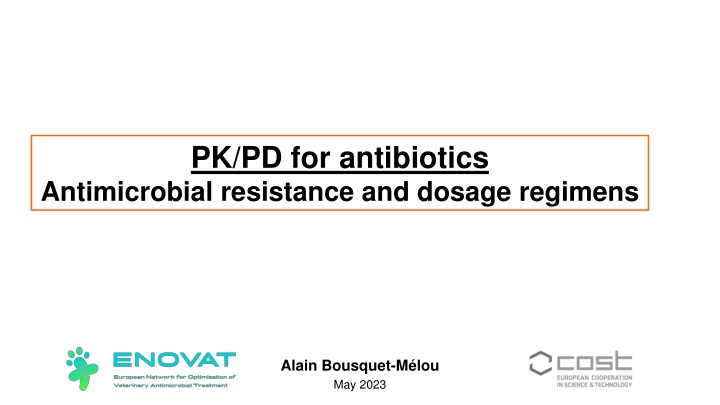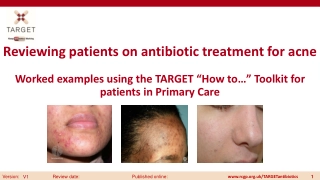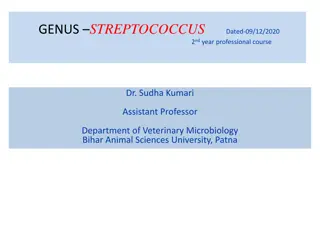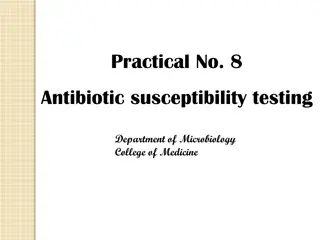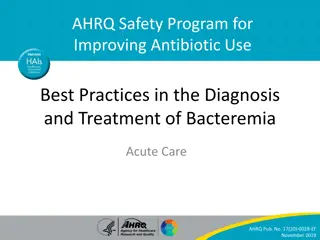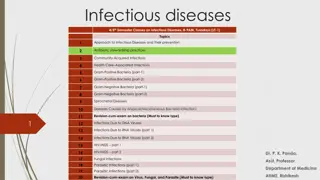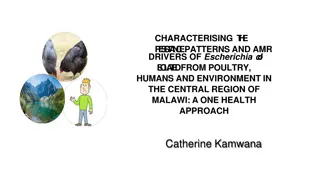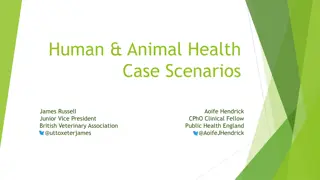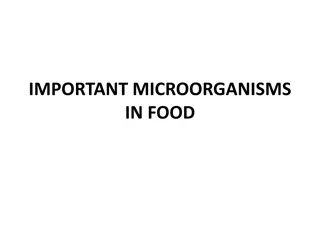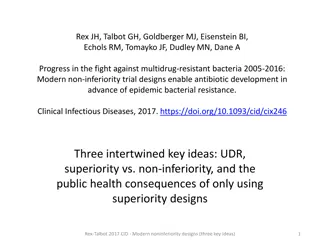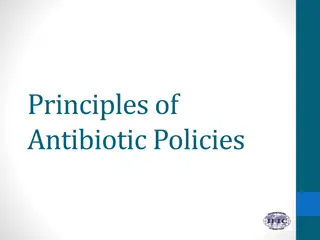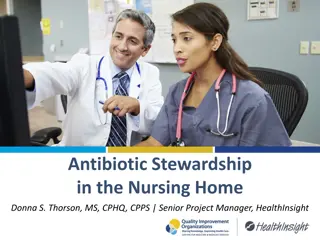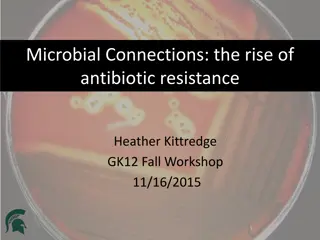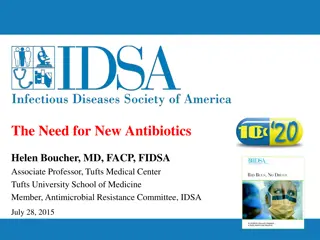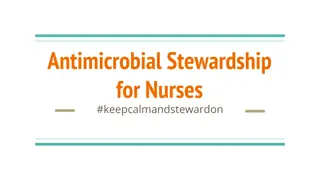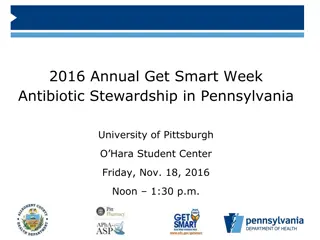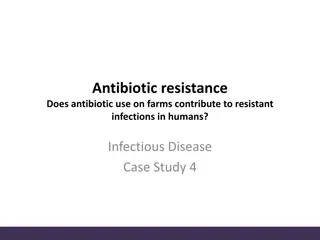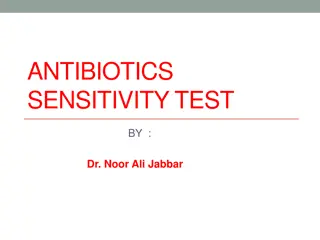Optimizing Antibiotic Therapy for Pathogenic Bacteria and Resistance
Understanding the pharmacokinetic/pharmacodynamic relationships in antibiotic therapy is crucial for maximizing effectiveness against bacteria while minimizing resistance. Different bacterial loads and stages of infection require tailored dosing regimens to achieve optimal outcomes. Monitoring antimicrobial resistance and selecting appropriate dosing strategies are essential components of targeted therapy for animal health and efficacy.
Download Presentation

Please find below an Image/Link to download the presentation.
The content on the website is provided AS IS for your information and personal use only. It may not be sold, licensed, or shared on other websites without obtaining consent from the author.If you encounter any issues during the download, it is possible that the publisher has removed the file from their server.
You are allowed to download the files provided on this website for personal or commercial use, subject to the condition that they are used lawfully. All files are the property of their respective owners.
The content on the website is provided AS IS for your information and personal use only. It may not be sold, licensed, or shared on other websites without obtaining consent from the author.
E N D
Presentation Transcript
PK/PD for antibiotics Antimicrobial resistance and dosage regimens Alain Bousquet-M lou May 2023
Optimized antibiotic therapy: what objectives? 1. Maximum effectiveness against pathogenic bacteria 2. Minimising the emergence and selection of bacterial resistance For target pathogens: efficacy/animal health issues 2
Antibiotic therapy and pharmacokinetic/pharmacodynamic (PK/PD) relationships With the recommended dosage Antibiogram: S Concentrations Peak / MIC (Cmax /MIC) Area24h under the curve / MIC (AUC24h / MIC) MIC Time > MIC ( f T > MIC ) Time 3
Antibiotic therapy and pharmacokinetic/pharmacodynamic (PK/PD) relationships With the recommended dosage Antibiogram: R AUC24h / MIC Peak / MIC concentrations MIC Time > MIC Time 4
A bacterial infection evolves over time Trigger of the disease Health Disease No symptom Symptoms Contamination by the pathogenic bacteria / Weakened immune system Growth of the initial inoculum 5
Different bacterial loads depending on the time of intervention during the infection Disease No symptom Symptoms Curative treatment Prophylaxis Metaphylaxis Bacterial load (infection site) High No Low 6
Optimized antibiotic therapy: what objectives? 1. Maximum effectiveness against pathogenic bacteria 2. Minimising the emergence and selection of bacterial resistance For target pathogens: efficacy/animal health issues High bacterial loads (inoculum) are heterogeneous 7
Large inocula are heterogeneous Resistant mutant "Age of infection Susceptible wild-type strain Antibiogram: S 8
Selection or prevention of resistance: the notion of a selection window Fluoroquinolones: Resistances appear by mutation (10-8 -10-9) on the genes coding for the targets of the antibiotics (gyrases, topoisomerases) High Doses ESPECIALLY WHEN deficits in host defences 9
Consequences for doses Kesteman, AAFC, 2009: In vivo: lung infection Bacteria: Klebsiella pneumoniae Antibiotic: marbofloxacin Later treatment 109 CFU % of rats with resistant 100 80 KP in lungs Higher doses 60 40 20 0 16 mg/kg 64 mg/kg 100 mg/kg marbofloxacin 10
Efficacy indices: clinical validation Pulmonary infections (nosocomial) treated with IV ciprofloxacin AUC/CMI strongly predictive of % bacterial eradication and time to achieve it AUC/CMI>125: very high % eradication AUC/CMI>250: eradication achieved on the first day of treatment % patients remaining 100 culture positive Higher doses AUC/MIC < 125 50 AUC/MIC 125-250 AUC/MIC > 250 0 8 12 4 Days after start of therapy Schentag Symposium, 1999 11
Early treatment / Inoculum size / Selection of resistant mutants Treatment onset / Standard dosage evolution of the infection Risk of selection of resistant clones Susceptible Resistant mutant Multiple mechanisms EXCEPT acquisition of new genes (plasmids) 13
Early treatment / Inoculum size / Selection of resistant mutants Treatment onset / Standard dosage evolution of the infection No risk of selection of resistant clones Susceptible Resistant mutant 14
Consequences for doses Kesteman, AAFC, 2009: In vivo: lung infection Bacteria: Klebsiella pneumoniae Antibiotic: marbofloxacin Early treatment 105 CFU Later treatment 109 CFU % of rats with resistant 100 80 KP in lungs Higher doses or 60 40 20 Doses earlier 0 16 mg/kg 64 mg/kg 100 mg/kg marbofloxacin 15
The importance of treating early 1. Reducing the risk of resistant mutants selection 16
Early treatment / Inoculum size / Tolerant bacteria Treatment onset / Standard dosage evolution of the infection Handb Exp Pharmacol. 2012;(211):121-33. Persister cells: molecular mechanisms related to antibiotic tolerance. Lewis K. Risk of relapse: evolution towards chronicity Sensitive Tolerant bacteria 17
Early treatment / Inoculum size / Tolerant bacteria Treatment onset / Standard dosage evolution of the infection Success / No evolution towards chronicity Susceptible WT Tolerant bacteria 18
The importance of treating early 1. Reducing the risk of resistant mutants selection 2. Avoid the presence of tolerant bacteria ("persisters") 19
Resistant vs. tolerant bacteria (Short) Improvement Failure before the end of treatment During treatment Intervention of HOST DEFENCES ? Able to CLEAR the remaining bacterial load ? After the end of treatment Improvement, apparent success Relapse after the end of treatment / Chronicity 20
Large inocula are heterogeneous Resistant mutant "Age of infection Risk of selection of resistant clones Biofilms Susceptible wild-type strain Risk of evolution towards chronicity Tolerant bacteria 21
Large inocula are heterogeneous Resistant mutant "Age of infection Risk of selection of resistant clones Susceptible wild type strain Risk of evolution towards chronicity Tolerant bacteria 22
Large inocula are heterogeneous Resistant mutant "Age of infection Risk of selection of resistant clones PROBABILISTIC ANTIBIOTICS INITIATED Susceptible wild-type strain AS SOON AS POSSIBLE Risk of failure: evolution towards chronicity Tolerant bacteria 23
To summarise Treating Fast/Early with High doses is a good combination for : Clinical cure Prevention of resistances at the infection site Hit hard and fast then leave as soon as possible Clinical cornerstone 2003 S3 (S21-S28) Hit hard and stop early Clinical Infectious Disease 2004 24
Optimized antibiotic therapy: what objectives? 1. Maximum effectiveness against pathogenic bacteria 2. Minimising the emergence and selection of bacterial resistance For target pathogens: efficacy/animal health issues For non-target bacteria: human health issues Zoonotic bacteria Animal commensal flora (reservoirs of resistance genes) 25
Veterinary antibiotics: critical bacterial flora Oral antibiotic Digestive tract Resistant zoonotic pathogens (Salmonella, Campylobacter) Commensal flora (resistance genes) EnvironmentX Foodborne infection Resistance gene pool Parenteral antibiotic Blood Food chain MEN PUBLIC HEALTH ? 5 5 Pathogen of veterinary interest ANIMAL HEALTH 26
Antibiotics in animals AB oral route Intestinal microbiota Zoonotic pathogens (Salmonella, Campylobacter) Commensal flora (resistance genes) Unfavourable AB parenteral route Blood Hit hard Veterinary Pathogen ANIMAL HEALTH Favourable 27
What strategy to preserve commensal flora? Duration of treatment Selection pressure 28
What strategy to preserve commensal flora? Lack of clinical trials in veterinary medicine that validate treatment durations Duration of treatment = EMPIRICAL CHOICE "the precise duration of treatment is not supported by solid evidence "not enough controlled clinical trials according to the World Health Organization 29
What strategy to preserve commensal flora? Impact of treatment duration on clinical success FLUOROQUINOLONE, BETA-LACTAM, MACROLIDE Treatment of acute exacerbations of chronic bronchitis 5 days of treatment = 7-10 days of treatment Falagas et al. JAC 2008:62 442-450 FLUOROQUINOLONE (levofloxacin) Treatment of pneumonia 750 mg for 5 days 500 mg for 10 days = Dunbar et al. CID 2003:37 752-760 30
What strategy to preserve commensal flora? Impact of treatment duration on clinical success AMOXICILLIN - AC CLAVULANIC Treatment of acute exacerbations of chronic bronchitis After re-evaluation at 3 days: placebo or amox-clav 7 days 3 days of treatment = 10 days of treatment Roede et al Clin Microb Infect 2007:13 284-290 RE-EVALUATIONS 3-5 DAYS FOR DECISION RE-EVALUATIONS DURING TRANSITIONS : Injectable / Oral Leaving the hospital 31
What strategy to preserve commensal flora? Impact of treatment duration on resistance emergence: commensal flora of the nasopharynx AMOXICILLIN: 90 mg/kg for 5 d vs 40 mg/kg for 10 d Isolation of penicillin-resistant S. pneumoniae from children less frequent Schrag et al JAMA 2001:286 49-56 PENICILLIN: treatment duration greater than 5 days Isolation of penicillin-resistant S. pneumoniae in children more common Guillemot et al JAMA 1998:279 365-370 32
Antibiotics in animals AB oral route Intestinal microbiota Zoonotic pathogens (Salmonella, Campylobacter) Commensal flora (resistance genes) Favourable AB parenteral route Blood short duration Veterinary Pathogen Hit hard ANIMAL HEALTH 33
Long-acting formulations should be questioned concentrations Commensal flora Different duration of exposure Threshold The same "efficacious" time Pathogenic inoculum Time 34
To summarize A favourable combination for : Clinical cure Prevention of resistances at the infection site Prevention of resistances in commensal flora Hit hard and fast then leave as soon as possible Clinical cornerstone 2003 S3 (S21-S28) Hit hard and stop early Clinical Infectious Disease 2004 35
